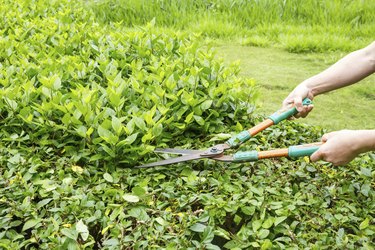
Cool-climate gardeners looking for low-maintenance, medium-height hedges find their answer in alpine currant (Ribes alpinum). Hardy in U.S. Department of Agriculture plant hardiness zones 2 through 7, the shrub's growth patterns and sunlight tolerances suit informal, natural hedges as well as classic, formal shapes. Early pruning encourages branching and enhances qualities that make alpine currants excellent hedging choices. Established hedges stay dense and attractive when properly pruned for health and shape.
Hedge-worthy Features
Video of the Day
Left unpruned, alpine currants grow up to 5 feet tall and 7 feet wide, but the shrubs respond well to heavy pruning and shearing. Hedges are easily kept at 3-foot heights. Alpine currant's natural upright, oval shape lends itself well to classic hedge forms. The versatile shrub prefers moist, well-drained soil but adapts to dry, compacted landscapes and drought. Shade tolerance -- uncommon among shrubs that drop their leaves in fall -- makes alpine currant a hedging favorite. The quality helps keep internal branches and lower stems covered in leaves from top to bottom throughout the growing season.
Video of the Day
Pruning Guides
Start alpine currant hedges with shrubs less than 2 feet tall, and cut them back by one-half at planting. This promotes dense branching from the bottom up. Before growth starts the next spring, identify new growth since your pruning. Remove one-half of that new growth. Remove one-half of new growth again the following spring. The third year, prune for shape. For classic hedges, cut the top flat or gently rounded. Then angle the sides so the base is slightly wider than the top. This lets in sun and keeps shrubs from shading themselves. Alpine currant's tolerance for shade helps, but proper pruning keeps hedges dense. For established natural hedges, prune alpine currants as needed for general shaping.
Timing the Task
Alpine currant's glossy, tri-lobed foliage is its only significant ornamental attribute. Don't be concerned with upcoming flowers or fruit. Plan your main annual pruning in late winter or early spring, right before new growth begins. With alpine currant branches free from leaves, your hedge's form is easily seen and shaped. Plan a second pruning for midsummer, after bright green spring foliage matures to dark green. Prune alpine currants when young, tender new growth reaches 6 to 8 inches long. Never let it go more than 12 inches or you'll lose the shape. Prune hedges to within 2 inches of your last prune.
Proper Tools
Electric-powered hedgers make quick work of hedges, but they often pull and tear woody stems. Sharp, old-fashioned, man-powered hedge shears make clean, crisp cuts. Bring long, errant stems back in line with sharp bypass pruning shears. Protect arms and legs from sharp, fresh-cut stems with long sleeves and long pants, and wear gloves and safety eyewear as well. Sterilize your hedging blades with household disinfectant before and after you prune. This helps prevent the spread of disease and insect pests.